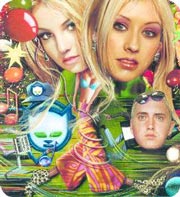TO CALL THE Year in Music 2000 uneventful would be a blind misstatement, or maybe a hopeful one. Who wouldn’t like to forget the two-headed chart-dominating monster that was Britney Spears and Christina Aguilera? Or the reality that rappers talented (Eminem, Ol’ Dirty Bastard), semi-talented (Black Rob), and not-so-talented (Puff Daddy) appeared more frequently in courtrooms than on stage? Or the incendiary topic of digital file sharing? The Napster debate led not to thoughtful discussion of the future of music distribution but to verbal barbs between artists and other artists, artists and fans, the music industry and the high-tech industry.
Real music, good music, barely registered a blip. Like a candle’s flame, a promising new band or event or trend would glow brighter for an instant, only to return to a steady, faint light. Radiohead’s Kid A almost miraculously topped the US charts when it debuted in October, selling more than 200,000 copies. A week later, a mediocre, ephemeral rapper named Ja Rule knocked the album out of the No. 1 spot, and it’d fade further from there. Where did it all go wrong?
We’d been given a clear foreshadowing in 1999, when the flames that engulfed the site of Woodstock symbolized the rage of youth. The careening sounds and fuzzy logic of hard-rock bands such as Limp Bizkit and the Red Hot Chili Peppers sparked the uprising. The fires burned, were stamped out, and then a pervasive gloom set in (soon exacerbated by rape allegations, some of which proved true).
Next came an even more aggressive amalgam of rock (and hip-hop) and irresponsibility, coupled with a bizarre, overly complex series of issues—Napster and the tramplings at Roskilde—that were eventually pushed to the background and finished to a dull glaze by the soulless pop confections of Britney, Christina, ‘N Sync, and the Backstreet Boys. Standing here on the verge of a new year, it’s as if we’re caught in midflicker, in an in-between space where the vibrancy and glow of America’s early ’90s music scene, with its various hot spots and hubs, may finally succumb to a lack of oxygen.
MAYBE THAT’S TOO BLEAK a stance. Maybe Eminem’s sharp-witted velocity is something to marvel at—leaving aside the sticky issues of misogyny and homophobia he raises. Perhaps the whole Napster/ digital distribution/copyright issue propels us, willingly or not, into the 21st century, forcing us to reconsider notions of ownership, compensation for artists, and even the way we listen to music—leaving aside the fact that two of the lightning rods on these points were the annoying Courtney Love and the ineloquent Metallica. And the bright side of the teen idols’ massive popularity could be that it’ll lead to another backlash and (pray) to the next Nirvana—leaving aside the reality that a wake of would-be Britneys and Backstreet Boys lurk on the 2001 release schedules of the money-fueled monoliths that control the music industry.
If we want to look on the bright side, however, how do we overcome the anachronisms that afflict almost all of music’s genres? Zack de la Rocha left Rage Against the Machine, the band that helped instigate the rise of aggro-rock while almost subversively distributing astute political messages to the hormonal masses, now leaving the field to brainless brutes like Fred Durst and incessant goofs such as Blink 182. Indie rock, once fertile intellectual soil for railing against commercialism, is now fallow; banished from almost any cultural significance, bands like Low, Badly Drawn Boy, and the Red House Painters have sold their songs for use in Gap ads. Critically lavished and surprisingly marketable acts like Radiohead and PJ Harvey proved that it’s possible to maintain artistic freedom—but album sales will top off at barely respectable numbers (by today’s Wall Street- driven standards). On the other hand, Moby proved to dance and electronic artists that it’s possible to sell more than a million records with a slight compromise of individuality.
Hip-hop, meanwhile, has become the most fascinating of all musical realms, where albums sell by the bucketload, where the stars influence fashion, where artists challenge each other’s proficiency and vocabulary, and where discernible scenes and styles have developed all over the country and in other parts of the world. (It’s also revivified R&B and soul, as evidenced by hip-hop-influenced Destiny’s Child and D’Angelo.) Atlanta’s OutKast served up the album of the year, Stankonia, the Wu-Tang Clan led a formidable parade from the Big Apple, Dre and others represented for LA, San Francisco’s comparably underground scene continued to flourish. Yet for all the inventiveness produced in these areas, the trends going into 2001 appear to be more heavy-handed, from the brash Detroit style of ghetto tech—which combines dizzying beats with lewd, lascivious raps—to Houston’s sonically lush, lyrically perverse Dope House style.
From a strictly critical point of view, Marshall Mathers and Dope House head Carlos Coy— who records as SPM, or South Park Mexican—can be judged as brilliant MCs or at least highly capable ones. And it’s certainly unsavory for any forward-thinking person to align with conservatives who moonlight as gangsta-rap critics. But when these artists so effortlessly combine catchy tunes with vivid lyrics that glorify mistreatment of women and violence, the portrayal isn’t of the rough-hewn street realities that hip-hop illuminated in its infancy, but of the privileged and in some cases troublesome worlds that a few choice stars inhabit.
How many listeners can relate to the just-released, infectious SPM song “Twice Last Night,” in which the rapper, anointed recently by Newsweek as “the biggest sound out of the Southwest,” details a peculiar variation on a first date: “So we had to take it elsewhere, take them to the Embassy, picked up a stripper friend with lesbian tendencies/Half black and Japanese/Gone on them Daiquiris/My bitch ate her out while I filled up her cavities.”
MUSIC’S CULTURAL IMPACT swings both ways, fortunately, and while today the lurid and vapid rule the charts and sway the marketplace, a groundswell of intriguing and intellectually stimulating acts could change things quickly—it only takes a spark to get things going again. In 2000, little-known artists such as Grandaddy, Bright Eyes, At the Drive-In, Modest Mouse, and Ryan Adams moved outside their respective regions and reached out to national audiences, while Europe produced a surprising number of rock start-ups that stirred US interest (Travis, Coldplay) and some whose fantastic albums never made the trip across the Atlantic (Idlewild, the Bluetones, Sigur Ros).
Add these to the coming crop in 2001, and a more progressive, artful sound with wide appeal doesn’t seem so unfathomable. Pavement’s Stephen Malkmus will release his first solo record in February, and it’s an eclectic, playful collection with a potential for pop upheaval. The Old 97’s also drop a new disc in February, likely to continue their journey from alt-country’s sidelines to the adult-radio playing field. The perennially dismissed Weezer will rise from the near-dead with a third album that could propel them from cult favorites to superstars. Hip-hop will hopefully hear again from its wittiest proponents, namely DJ Shadow and Prince Paul. As dance artists evolve into songwriters, their genre will provide more influential entries as well.
They’ll all find it hard to compete with the perky bodies and emotive vocals, the raunchy narratives and bludgeoning beats that were the hallmarks of the Year in Music 2000, but hopefully they’ll try. Otherwise, well, does anybody have a match?






